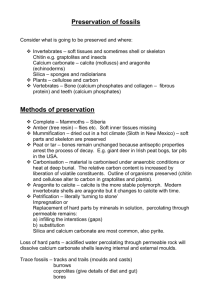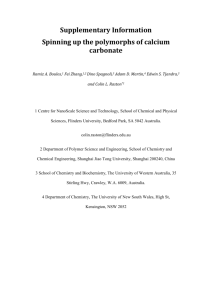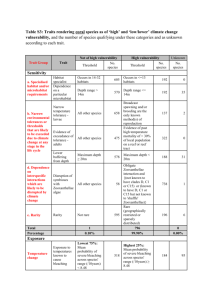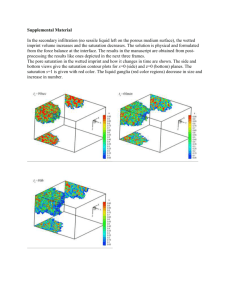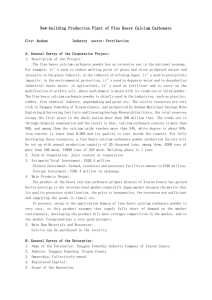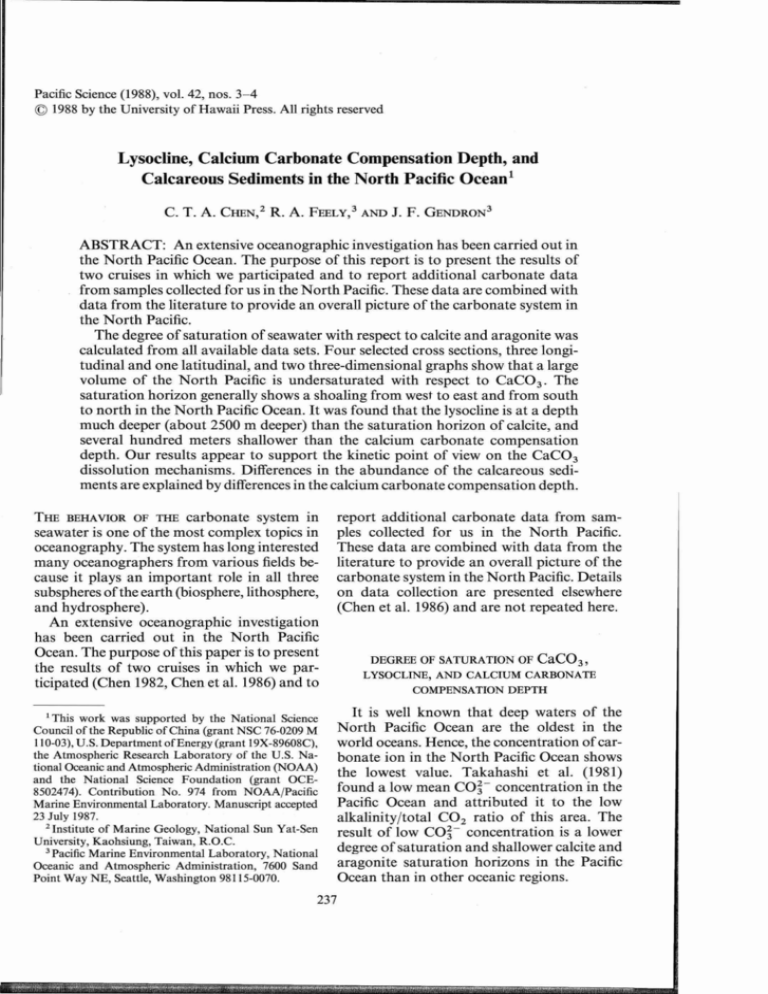
Pacific Science (1988), vol. 42, nos. 3-4
© 1988 by the University of Hawaii Press. All rights
reserved
Lysocline, Calcium Carbonate Compensation Depth, and
Calcareous Sediments in the North Pacific Ocean!
C. T. A. CHEN,2 R. A. FEELy,3 AND J. F. GENDRON 3
ABSTRACT: An extensive oceanographic investigation has been carried out in
the North Pacific Ocean. The purpose of this report is to present the results of
two cruises in which we participated and to report additional carbonate data
from samples collected for us in the North Pacific. These data are combined with
data from the literature to provide an overall picture of the carbonate system in
the North Pacific.
The degree of saturation of seawater with respect to calcite and aragonite was
calculated from all available data sets. Four selected cross sections, three longitudinal and one latitudinal, and two three-dimensional graphs show that a large
volume of the North Pacific is undersaturated with respect to CaC0 3. The
saturation horizon generally shows a shoaling from west to east and from south
to north in the North Pacific Ocean. It was found that the lysocline is at a depth
much deeper (about 2500 m deeper) than the saturation horizon of calcite, and
several hundred meters shallower than the calcium carbonate compensation
depth. Our results appear to support the kinetic point of view on the CaC0 3
dissolution mechanisms. Differences in the abundance of the calcareous sediments are explained by differences in the calcium carbonate compensation depth.
THE BEHAVIOR OF THE carbonate system in
seawater is one of the most complex topics in
oceanography. The system has long interested
many oceanographers from various fields because it plays an important role in all three
subspheres of the earth (biosphere , lithosphere,
and hydrosphere).
An extensive oceanographic investigation
has been carried out in the North Pacific
Ocean . The purpose of this paper is to present
the results of two cruises in which we participated (Chen 1982, Chen et al. 1986) and to
1 This work was supported by the National Science
Council of the Republic of China (grant NSC 76-0209 M
110-03), U.S. Department of Energy (grant 19X-89608C),
the Atmospheric Research Laboratory of the U.S. National Oceanic and Atmospheric Administration (NOAA)
and the National Science Foundation (grant OCE8502474). Contribution No. 974 from NOAA /Pacific
Marine Environmental Laboratory. Manuscript accepted
23 July 1987.
2 Institute of Marine Geology, National Sun Yat-Sen
University , Kaohsiung, Taiwan, R.O.C .
3 Pacific Marine Environmental Laboratory, National
Oceanic and Atmospheric Administration, 7600 Sand
Point Way NE , Seattle, Washington 98115-0070.
report additional carbonate data from samples collected for us in the North Pacific.
These data are combined with data from the
literature to provide an overall picture of the
carbonate system in the North Pacific. Details
on data collection are presented elsewhere
(Chen et al. 1986) and are not repeated here.
DEGREE OF SATURATION OF CaC0 3,
LYSOCLINE, AND CALCIUM CARBONATE
COMPENSAnON DEPTH
It is well known that deep waters of the
North Pacific Ocean are the oldest in the
world oceans. Hence, the concentration of carbonate ion in the North Pacific Ocean shows
the lowest value. Takahashi et al. (1981)
found a low mean CO~ - concentration in the
Pacific Ocean and attributed it to the low
alkalinity/total CO 2 ratio of this area. The
result of low CO~ - concentration is a lower
degree of saturation and shallower calcite and
aragonite saturation horizons in the Pacific
Ocean than in other oceanic regions.
237
PACIFIC SCIENCE, Volume 42, July/October 1988
238
The distribution of the degree of saturation of seawater with respect to calcite and
aragonite is presented below . The relationships between the saturation state and the
calcium carbonate compensation depth and
the lysocline are also addressed.
METHOD OF CALCULATING THE D EGREE OF
SATURATION
In calculating the degree ofsaturation ofseawater with respect to calcite and aragonite, we
need to calculate the carbonate ion concentration from the measured carbonate data. The
CO~- concentration in seawater at in situ
temperature and pressure conditions has been
computed from the NOAA Eastern North
Pacific CO 2 Dynamics Cruise, 1981 (ENP),
and . Western North Pacific CO 2 Dynamics
CrUl~e ,. 1982 (WNP), salinity, temperature,
alkalinity, pH, and calcium data. In addition
to our two meridional sections along 1650 E
and 1500 W, all GEOSECS (Geochemical
Ocean Section Studies, 1973-1974[GS]) and
INDOPAC (Scripps Institute of Oceanography, 1976 [IP]) alkalinity and total CO 2 data
from the North Pacific Ocean are used to
calculate the degree of saturation of seawater.
Two cross sections, one longitudinal along
roughly 1800 Wand one latitudinal along
roughly 350 N, are selected from GEOSECS
stations to demonstrate the distribution of
saturation values. The effects of pressure on
the dissociation constants for carbonic and
boric acids determined by Culberson et al.
(1967) and Culberson (1972) are used for the
computation. Our expression for the saturation states for calcite and aragonite in seawater is in percent of saturation:
ICP
n= - K~p
x 100%
where ICP (ion concentration product) =
[Ca2+] x . [~O ~ - ] (M jkg)2 and K~p = apparent solubility product for calcite or aragonite.
The apparent solubility products for calcite
and aragonite in seawater at 1 atm total pressure determined by Ingle et al. (1973) and by
Berner (1976), respectively, are used. In order
to obtain the apparent solubility product at in
situ conditions, the pressure effects on the
solubility products summarized by Culberson
(1972) are used .
DEGRE E OF SATURATION OF TH E
SURFA CE WATER
Figures I a and 1b show the correlation
of temperature with the degree of saturation
of sea~ater with respect to calcite (nJ and
aragomte (n a ) , respectively, for the surface
waters of the North Pacific Ocean. It is evid~nt that all surface waters are supersaturated
With CaC0 3 (Alekin and Katunin 1973). Linear correlations between nc , na, and temperature are found in the data sets for both figures. A high degree of saturation is observed
in high -temperature Pacific surface seawater
(Lyakhin 1968) for calcium carbonate. The
degree of saturation is strongly influenced by
the titration alkalinity (TA) versus total CO
(TC0 2) ratio, which also shows a linear de:
pendence on surface temperature as suggested
by Feely et al. (1984).
The isopleths of the surface saturation values are shown in Figures 2a and 2b for calcite
and ~r~go.nite, respectivel y. The overall pattern is Similar to the temperature distribution
which in turn is influenced by the surface
oceanographic circulation and other factors .
The n c and n a decrease slightly from west to
east. In the western subarctic regions low n
and n, are also found in the cold 'G ulf of
Alaska. A sharp change occurs from north
to south at the region of mixing between the
cold Oyashio and the warm Kuroshio around
40 0 N . A poorly defined area of high n c and
na values occurs near the center of the subtropical gyre west of Hawaii.
Figures 2a and 2b represent mainly summer
conditions, and the contours are likely to
move southward in winter as surface temperature decreases. For instance, Lyakhin (1970)
reported 300-400% saturation of calcite in
the Sea of Okhotsk in summer but less than
150% saturation in winter.
Lysocline, Calcium Carbo nate Compensatio n Depth, and Sediments- CHEN, F EELY, AND
G ENDR ON
239
T,OC
10
5
25
20
15
200
•
ENP
o
WNP
• IP
A GS
o
300
""
Oc
aa
a
400
a
lllx>C\ aa
a a
a.t
a a
a aa
"
o
a a
"
500
"
"
..
"
600
"
a
T, °C
5
10
20
15
25
• ENP
o WNP
a IP
o
..
200
A
GS
300
e
400
F IGURE
by eye.
I
a
A
b
1. Corre lation of surface (a)
" ..
A
0
"
.
A
AA
nc and (b) n. with temperature in the North Pacific. The lines are roug h fits
240
PACIFIC SCIENCE, Volume 42, July /October 1988
N
, ,....
-,
•
0
o •
...
.
...
o
•
0
0
0
...
~
•0
...
...
•
•
0
/'
...
I~
> 400
/ 0/ •
0/0
o
I
{ 0
10
o
~, - -400- ,
o
\
o
300
... •... ... ...
" -, ...... ...
..
_--
.,
/
o
/
/
•
10
•
o
b
o
140 E
160
180
160
140
o
120W
FIGURE 2. Distr ibution of sur face (a) n, and (b) n. in the Nor th Pacific Ocean. A reas enclosed by dashed circles
probabl y have th e highest degree of supersaturation.
Lysocline , Calcium Carbonate Compensation Depth, and Sediments-CHEN, FEELY, AND GENDRON
VERTICAL DISTRIBUTION OF DEGREE OF
SATURATION
Four cross sections of saturation values
of calcite and aragonite are plotted from the
ENP, WNP, and GEOSECS data.
1. The 35° N Cross Section
The latitudinal cros s section along approx.
35° N was selected also by Takahashi (1975),
who used TC0 2 data unadjusted for the fossil
fuel CO 2 input to calculate saturation values;
and only n c was calculated in his paper. The
revised carbonate data (Takahashi et aI. 1980)
are used to recalculate the degree of saturation
of both calcite and aragonite. The results are
shown in Figures 3a and 3b. A very small
variation in the degree of saturation is found
in the water column below 1000 m depth. The
saturation horizons shoal from west to east
because of the general surface circulation pattern in the North Pacific Ocean. The western
North Pacific has the deepest saturation horizon at a depth of I 100 m. The intensified
western boundary current results in the deep ening of the saturation horizon. Characteristic minimum n c and n a layers can be seen
across the entire ocean from coast to coast.
These minimum layers are relatively narrow
and are not shown in Takahashi's (1975) pro file. These layers are strongly related to the
region of highest partial CO 2 pressure (P co,)
concentrations in the oxygen minimum layer
(Figure 4). The low saturation values found in
this layer are caused by oxidation of organic
matter, releasing carbon dioxide and reducing
the carbonate ion concentration.
2. The 165° E Cross Section
Figure 5a shows the distribution of the
saturation values of calcite along 165° E. The
saturation horizon deepens from less than
150 m in the north to > 3000 m at 25° N .
Figure 5b shows the depth of the aragonite
saturation horizon at less than 100 m in the
north, at 750 m at 30° N , and at 500 m at
15° N . Byrne et al. (1984) studied the dissolution rate of aragonite particulates collected
using free-drifting sediment traps during the
241
Discoverer cruise (Betzer et al. 1984). Their
findings revealed that the depth at which a
high dissolution rate of aragonite was found
is shallower at high latitudes than at midlatitudes. These findings support our saturation profile , which shows a concave structure
at mid-latitudes. A similar structure was reported by Betzer et al. (1984).
A sharp change from undersaturation to
supersaturation for calcite is found between
stations WNP5 and WNP6. The oversaturated water at WNP3 and WNP5 may be the
result of the younger age of the seawater in
that region . Station WNP6 defined the southern limit of North Pacific deep water that has
low oxygen and high nutrients. Such a sharp
change of the saturation value from north
to south also was observed by Hawley and
Pytkowicz (1969) along their 170° W cross
section. We do not have sufficiently deep samples at WNP3 and WNP5 to see the distribution of saturation values down to the bottom.
A core of low saturation is found as a tongue
extending from north to south at a water
depth of 700 m.
The saturation horizon also is affected by
the surface circulation. A depression of the
saturation surface at 30° N is located slightly
south of the subtropical convergence zone.
The 100% saturation horizon almost reaches
a depth of 100 m at 50° N. Again , upwelling
must play an important role in governing the
depth of this shallow saturation horizon.
Similar results were reported by Feely et aI.
(1984) for waters above 1000 m.
3. The 180° W Cross Section
Takahashi (1975) selected similar but not
identical cro ss sections . Only the calcite saturation was calculated from the original
GEOSECS data set in his paper. As in the
165° E cross section , the contour lines in the
surface layer exhibit a concave, downward
structure at mid-latitudes (Figures 6a, 6b).
The 100% n, contour and 70% o, contour
deepen from 300 m at the north to 2200 m at
the south. Such a trend may depict the largescale upwelling phenomenon of the deep water of the northern region . The cores of low
saturation values are observed in both Figures
Long 14 0 0 E
Long. 14 0 0 E
204 20 2
224 223
~oo
.
i
201
o
-_:--:_; :::t=;=_
~ _~~
-+----:
:
:
;---:
80
.
:~
~ 300;
2000
.
. ..
... ..
.: .
.
< 80
2000
/
E
20 4
•
•
.
•
'
201
~_-+
~
--r_~:/~.
:
.
: <60
•
202
~
~: 6 0
•
a.
.
10 00
80
s:
21 2
I
14 0°
I
b~ ~~-.--..;:..-....-::.;..·--~
IQO
~
1
GS 22 4 2 3
I
...:.---;.- 200
10 00
16 0 °
180"
I
I
~
.
.
.
..
60.·
.
..
.
.
.
· .
.
. ..
> 60
.
.
•
E
30 0 0
.;:
Q)
3000
0.
o
Q)
o
4000
- -- -
./ '
--80
.
~
.....5000
60 ~
40 0 0
(60
5000
0
6000
6000
FIGURE 3. Cro ss section of (0) n. and (b) n. along 35° N. Dashed line represents calcium carbonate com pensatio n
depth data (CCD) from Berger et at. (1976).
0,%
b
Lysocline, Calcium Carbonate Compensation Depth, and Sediments-CHEN, FEELY, AND GENDRON
PCO, (~ATM)
OXYGEN (mL/L)
a
I
2
3
4
5
6
a
CALCITE SATURATION (%)
300 600 900 1200 1500
a
100 200 300 400 500 600
243
ARAGONITE SATURATION (%)
a
100 200 300 400 500 600
1000
]
ADIOS-I
21 March - 19 April 1986
26°00'N 155°00'W
2000
I
tw
0
3000
4000
5000
FIGURE 4 . Vertical profiles of dissolved oxygen (ml/liter), PCO z (uatm), calcite saturation (%), and aragonite
saturation (%) at the ADIOS-I (Asian Dust Input to Ocean System-I time series station (26°00' N, 155°00' W). The
data are a composite of nine vertical profiles taken from 21 March through 19 April 1986. The minima in calcite and
aragonite saturation correlate with the maximum in PCO z .
6a and 6b. Takahashi (1975) did not show this
minimum core in his paper.
Similar results for aragonite were reported
for waters above 1000 m by Feely et al. (1984).
4. The 1500 W Cross Section
This data set was presented by Feely and
Chen (1982), who used the estimated calcium
concentration to calculate the ionic product
for the data above 1500 m. Figures 7a and 7b
show our results of recalculated saturation
values using measured calcium concentrations for all the samples taken. The distribution pattern is similar to the cross section
along 1650 E .
Similar results were given by Feely and
Chen (1982) for waters above 1.5 km .
5. Subsurface Distribution of the 100%
Saturation Horizons for n a and n c
Figures 8a and 8b give three-dimensional
representations of the 100% saturation horizons for n c and n a , respectively. The data
are based on the NOAA ENP, CNP (Central
North Pacific Dynamics Cruise, 1983), and
SOCM (Summer Ocean Carbon Monitoring)
data sets (Feely, unpublished data), as well as
the GEOSECS and INDOPAC data. Interpolation is done by spline fits between data
sets. Also given in figure 8b is the depth of the
26.7 at (at = [Pt - 1] x 1000) surface, which
J
""
shows a close correspondence with the 100%
saturation horizon. This correspondence indicates that circulation in the upper water
column is the major factor controlling the
saturation horizons. The figures show that the
100% saturation horizons are shallowest in
the cold-water region north of the subarctic
front. In the northwest Pacific, the 100% horizon reaches its shallowest depth (z = 220 m
for calcite and z = 110 m for aragonite) at
about 50 N, whereas farther to the east the
saturation horizons are slightly deeper (z ~
290 m and z ~ 170 m, respectively, for calcite
and aragonite). The shallow levels of the horizons north of the subarctic front are a result
of the general cyclonic circulation within the
subarctic gyre, where intensive upwelling produces a doming of the saturation isopleths. In
the western Pacific, the deepest 100% saturation horizons are found in the region south of
the subtropical front at about 33 N . Intensified vertical mixing induced by the Kuroshio
extension results in the deepening of the saturation horizons in this region. As indicated by
the oxygen distributions of Reid (1965) and
the tritium data of Ostlund et al. (1979), mixing and lateral transport of the North Pacific
intermediate water induces greater vertical
exchange with upper water than the subarctic
waters further to the north .
Another important factor affecting the
depth of the saturation horizons is the buildup
of TC0 2 relative to T A underneath the high
0
0
PACIF IC SCIENCE, Volume 42, Jul y/October 1988
244
15°
Lot.:
3
5ta .
20°
25°
30°
35°
40°
4So
I
I
I
I
I
I
8
6
5
12
9
16
14
SOoN
18
20
~500
:
:
400
300 -;-_ _---;.
:
-
-200
100
1000
E
80
2000
.'
Oc
I
a
%
3000
15°
Lat.I
5ta.
------..:
3
20°
25°
30°
35°
40°
I
I
I
I
I
5
8
6
~.300
: -
'
~
:
-
-
:
:
10 0
. 14
:
":
:
'
•
.
.
'
.
:
.
:
:
.
I
---:--
12
16
SOoN
18
20
~
;: ,:
' ~.
.;.'
.
200 ----0-
.
9
4So
--- '
70
: :
.
:
.
.,
'
.
' .
.
. :
:
•
60
1000
E
E
a.
<IJ
o
2000
Oa
1%
3000
FIGURE
5. Cross section of (a) Q c and (b) Q . along 165° E.
b
Lat. lo oN
1
GS 238
I5°
25°
20°
1
30°
I
233
214
35°
40°
I
I
2 15
45°
500
217
Lat. lOON
55°N
I
I
I
218
2 19
O ~=:
__....-__
:
GS 238
15°
20°
I
1
25°
I
233
214
200
1000
~
100
2000 /
.c 80
:
2000
3000
'"
4000
:---
-
-
-
---
--
,-
80
Oe ,
6000
700 0
-=a.
'"
/
90
0
~
/
~
50°
,
I
215
217
I
219
< 60
/
-,
\
"
0
4000
~
60
~
5000
na,%
%
60 00
a
2 18
55°N
»>: 80
E
/ .
-=a.
45°
I
3000
/
E
40°
__ ._--
70
:. .>
:
I
~::
100
.
35°
°rt:::-----.J~---__===i='"'"__=
j:::===prh
--'!
~300
1000 )
30°
7
b
FIGURE 6. Cro ss section of (a) nc and (b) n. along 180° W. Dashed line represent s calcium carbona te compen sation
depth dat a (CCD) from Berger et al. (1976).
•
I
-:---...
./
,.
1000.
I
\
E
100
~TO
·~:
60 .
.
\
-
..c:
a.
w
0
2000·
b
3 0 0 0 ' - - - - - - - - - - - - - - - - - - -- -- - - -- - - - 1
FIGURE
7. Cross section of (a) n. and (b)
n. along 150
0
W.
DEPTH
Om
-200
bi
I
FIGURE 8. Three-dimensional repre sentations of the 100% saturation horizon s for (a)
26.7.
0", =
I
_N
. . ... ..,
""i4>
Qo
and (b)
Q a.
For (b),
248
PACIFIC SCIENCE, Volume 42, Jul y/October 1988
is equal to the saturation value of 91% Qe.
This value is adopted in this report as a qualitative reference for the lysocline depth. The
term " qualitative" is used carefully because of
the uncertain depth at which Q e = 91% falls.
A large amount of water in the North Pacific
has a calcite saturation value of 90-100%.
The scattering of data also contributes too
much noise for the Q e = 91% depth to be
defined precisely.
In Figures 3a and 6a the CCO according to
Berger et al. (1976) is shown. As can be seen,
the CCO usually falls at a depth above the
80% Q e contour in the mid-latitude region.
Figure 6a shows a shoaling of the CCO north
of40° N to a depth where the Q e value is larger
than 90%. If the 90% Q e contour were defined
THE RELATIONSHIPS AMONG Q e,
as the lysocline in the North Pacific, then the
LYSOCLI NE , AND CALC IU M CARBONATE
CCO generally falls at a depth deeper than the
COMP EN SAnON DEPTH
lysocline, and the lysocline generally falls at a
The mechanisms that control the distribu- depth deeper than the saturation horizon of
tion of calcium carbonate-rich sediments are calcite.
Station GS233 is selected for the purpose
not clear. The relationships among the saturation horizon, lysocline, and calcium carbon- of discussion of the relationships among Qe ,
ate compensation depth (CCO) have been in- the lysocline, and the CCO. This station is
vestigated by many workers (Broecker and selected because it is located near the station
Takahashi 1978, Edmond and Gieskes 1970, at which Peterson's (1966) in situ experiment
Heath and Culberson 1970, Li et al. 1969, was carried out. The vertical distributions of
Lisitzin 1972, Pytkowicz 1970, Takahashi carbonate ion concentration and normalized
1975). In order to examine these three prop- alkalinity at GS233 from the surface to the sea
erties, we need to know the distribution of bottom are shown in Figure 9. Even taking
the saturation horizon, lysocline, and CCO. into consideration the maximum uncertainty
Peterson (1966) and Berger (1967) carried out in the determination of the saturation horizon
in situ experiments of the dissolution ofcalcite (Plath et al. 1980,Pytkowicz 1983), the saturain the central North Pacific Ocean (18°49' N, tion horizon at 750 m is still much shallower
168°31' W). They found that the rate of dis- than the lysocline and CCO depths. The depth
solution of calcite increases sharply at a depth of the lysocline (~3500 m) estimated from
of about 3700 m. This depth is called the dpH is consistent with that of Peterson (1966).
lysocline. Unfortunately, this kind of experi- The CCO at about 4400 m (Berger et al. 1976)
ment is scarce. An indirect approach to study- is also shown in the figure. The differences in
ing the lysocline was carried out in laboratory the depths of the three parameters-saturaexperiments by Morse and Berner (1972) and tion horizon, lysocline, and CCO-cannot be
Berner and Morse (1974) by examining the explained except by kinetics.
parameter dpH, the difference between the
The carbonate ion concentration increases
pH for the calcite-seawater equilibrium and slightly below the saturation horizon, but this
the seawater pH . Takahashi (1975) suggested increase cannot be attributed to the dissolua Apl-I value of 0.08 rather than the 0.15 pro- tion of CaC0 3 alone. Physical conditions and
posed by Morse and Berner (1972), as an in- pH values due to the speciation of carbonic
dicator of a sharp increase in the dissolu- acid also affect the concentration of CO~ ­
tion rate of calcium carbonate. According to ion . Nevertheless, the general increasing trend
Berner and Wilde (1972), a dpH value of 0.08 of CO ~- concentration and the decreasing
productivity regions, which causes enhanced
shoaling of the 100% saturation surfaces.
This effect is evidenced by the upward slope
of the Q e and Q a saturation surfaces in the
eastern Pacific. The increased acidity resulting from enhanced respiration processes decreases the carbonate ion concentration to
the extent that the waters are undersaturated
much closer to the surface. This effect is significantly enhanced in highly productive upwelling areas such as those of the equatorial
waters of the eastern North Pacific or the
nutrient-rich subarctic waters north of the
subarctic front.
Lysocline, Calcium Carbonate Compensation Depth, and Sediments- CHEN, F EELY,
2300
NTA
2-
0
CO a
Oc
0
2350
10 0
2400
10 0
200
2450
200
300
2000
E
~
.c
a.
CD
0
3000
4000
5000 ri,
9. Vertical distributions or n e, CO~ -, and NTA at 08233.
NTA
249
()Jeq/kg)
()JmoVkg)
400
1000
F IGURE
AND G ENDRON
(%)
PACIFIC SCIENCE, Volume 42, July /October 1988
250
trend of saturation value below the saturation
horizon still indicate the importance of the
solubility product in the saturation value for
deep waters.
Normalized titration alkalinity (NTA =
TA x 35/salinity) is independent of temperature , salinity, and pressure effects if measurements are taken per weight unit. Hence , NTA
distribution may serve as a better indicator of
CaC0 3 dissolution than CO~- ion concentration . The significance of a maximum NTA
layer is noted here. The maximum NTA layer
generally lies at a depth between 3000 and
3500 m in the North Pacific and is alway s
shallower than both the lysocline and the
CCD. This situation was not expected because
the deep lysocline and CCD should imply
more CaC0 3 dissolution below these depths,
and an increasing trend should be found . An
explanation for this phenomenon is that the
rate of dissolution of CaC0 3 is not fast
enough to overcome the flushing of the bottom water in that region. The location of
GS233 is one of the main passages of the
Pacific bottom water, with a relatively high
FIG UR E
1976).
current speed of about 10 cm/sec originating from the southern ocean (Edmond et al.
1971). The rate of delivery of low-alkalinity
bottom water is higher than the rate of in situ
production from dissolution of CaC0 3 •
DISTRIBUTION OF CARBONATE IN SURFACE
SEDIMENTS OF THE PACIFIC O CEAN
Berger et al. (1976) provided a detailed map
of calcium carbonate percentages in Pacific
surface sediments. Their results for the North
Pacific are reproduced in Figure 10. In general,
carbonate-rich sediments are scarce north of
15° N, presumably due to a predominance of
sea floor at or below the calcite and aragonite
compensation depths (Figure 3-8) . The calcium carbonate compensation depth deepens
south of 25° N (Figures 5-8). The deepening
corresponds to a narrow zone of transition
between low and high surface carbonate content between 15° and 10° N. The calcium carbonate percentages reach more than 80% in
10. A contour map of calcium carbonate percentages in the N orth Pacific sediments (fro m Berger et al.
Lysocline, Calcium Carbonate Compensation Depth, and Sediments- CHEN,
the equatorial region, reflecting the deepening
of the calcium carbonate compensation depth.
CONCLUSION
The degree of saturation with respect to
calcite and a ragonite was calculated from all
available data sets . Four selected cross sectio ns , three lo ngitudinal and o ne latitudinal,
a nd two th ree-d ime nsiona l graphs show that
a large volume of the North Pac ific is undersa turated with respect to CaC0 3 . The sa turation horizon gen erally shoals from west to east
and from so uth to north in the North Pacific
Ocean. It was found that the lysocline falls at
a depth mu ch deeper (about 2500 m deep er)
th an the sat u ra tion horizon of ca lcite a nd
several hundred meter s shallower th an th e
ca lcium ca rbona te compensation dep th. Our
result s appear to support th e kinetic poi nt of
view on the CaC0 3 dissolu tio n mechanisms.
The calcium carbonate compensation depth
deepens south of 25° N . A narrow zone of
transition between low and high surface carbonate content exists between 15° and 10°
The calcium carbonate percen tages reach
more than 80 % in the equatorial region, reflecting the deepening of the calcium ca rbonate
compensation depth .
ACKNOWLEDGMENTS
M. R. Rodman , C. L. Wei , and E . J . Ol son
provided va lua ble ass istance. An ano nymo us
reviewer provided valuable sug gestions. We
al so wish to th ank Peter R . Betzer for inviting
us to participate in the ADIOS Program.
LITERATURE CITED
ALEKIN, D. A., and I. M. KATUNI N. 1973.
Saturation of calcium carbona te in the sur face waters in the ocea ns . Ocean o\. 13 : 2 152 19.
BERGER, W . H . 1967. Foram iniferal ooze: Solution at depths. Science 156: 383-385.
BERGER, W. H. , C. G . A DELSECK, JR., and
L. A. MAYER. 1976. D istribution of carbonate in surface sediments of the Pacific
Ocea n. J. G eop hys. Res. 81 :2617-2627.
BERNER, R . A. 1976. T he solubility of cal -
F EELY, AND
G ENDRON 251
cite and aragonite in seawater at one atmosphere and 34.5 parts per thousand. Amer.
J . Sci. 276 :713-730.
BERNER, R . A ., and J . W. MORSE. 1974. D issol ution kinetics of CaC0 3 in seawater IV.
Theory of calcite dissolution . A mer. J . Sci.
274 : 108-134.
BERNER, R . A. , an d P. Wilde. 1972. D issol utio n kinetics of CaC0 3 in seawater
I. Saturation state parameters for kin etics
calculations. A mer . J . Sci. 273: 826- 839.
BETZER, P . R. , R. H . BYRNE, J . G. A CKER,
C. S. LEWIS, R . R. JOLLEY, and R. A. F EELY.
1984. The oceanic carbonate system : A
reassessment of biogenic controls. Science
226: 1074-1077.
BROECKER, W . S., and T . TAKAHASHI. 1978.
The relati on ship between lysocline depth
and in sit u ca rbo nate ion concentration.
Deep-Sea Res. 25: 65-95.
BYRNE, R . H ., J . G . ACKER, P. R . BETZER,
R. A . FEELY, and M. H. CATES. 1984. Water
column dissolution of aragonite in the
Pacific Ocea n. ature 312: 32 1- 326.
CHEN, C. T. A. 1982. Oceanic penetration
of excess CO 2 in a cross section between
Alaska and H awaii. Geop hys. Res. Lett .
4: 117-119.
CHEN, C. T. A. , M. R. RODMAN, C. L.
WEI, E. J. OLSON, R. A . FEELY, an d J. F.
G ENDRON. 1986. Carbonate chemistry of
the North Pacific Ocean. U .S. Dept. Ene rgy
Techn. Rep t. DOEjNBB-0079. W ashin gton, D.C.
CULBERSON, C . H. 1972. Processes affecting
the oceanic distribution of carbon dio xide.
Ph.D. Thesis. Oregon State University, Corvallis.
CULBERSON, C. , D. R. K ESTER, and R . M.
PYTKOWICZ. 1967. Hi gh-pressure dissoc iation o f carbon ic a nd boric acids in seawater.
Science 157 : 56-6 1.
EDMOND, J . M ., and J . M . T. M . G IESKES.
1970. On the calculation of th e degree of
saturation of seawater wit h respect to calciu m carbonate under in situ conditions.
G eochim. Cosmochim. Acta 34: 1261- 1291.
EDMOND, J . M. , Y. CH G, and J. G. SCLATER.
1971. Pacific bottom water: Penetra tio n
east around Hawaii. J . G eoph ys. R es. 76:
8089-8097.
252
PACIFIC SCIENCE, Volume 42, July/October 1988
FEELY, R. A., and C. T. CHEN. 1982. The effect
of excess CO 2 on the calculated calcite and
aragonite saturation horizon in the northeast Pacific. Geophys. Res. Lett. 9: 12941297.
FEELY, R. A ., R. H. BYRNE, P. R. BETZER,
J. F. GENDRON, and J. G. ACKER. 1984.
Factors influencing the degree of saturation
of the surface and intermediate waters of
the North Pacific Ocean with respect to aragonite. J . Geophys. Res. 89: 10631 -10640.
HAWLY, J., and R. M. PYTKOWICZ. 1969. Solubility of calcium carbonate in seawater
at high pressures and 2°C. Geochim. Cosmochim. Acta 33 : 1557-1561.
HEATH, G . R., and C. H . CULBERSON. 1970.
Calcite: Degree of saturation, rate of dissolution, and the compensation depth in the
deep oceans. Geol. Soc. Amer. Bull. 81:
3157-3160.
INGLE, S. E., C. H. CULBERSON, J. E. HAWLEY,
and R. M. PYTKOWICZ. 1973. The solubility
of calcite in seawater at atmospheric pressure and 35%0 salinity. Mar. Chern. 1: 295307.
LI, Y. H. , T . TAKAHASHI, and W. S. BROECKER.
1969. Degree of saturation of CaC0 3 in the
oceans. J. Geophys. Res. 74: 5507-5525.
LISITZIN, A. P. 1972. Sedimentation in the
world ocean. Soc. Econ. Paleontol. MineraI. Spec. Pub. 17. Tulsa.
LYAKHIN, y. 1. 1968. Calcium carbonate saturation of Pacific water. Oceanol. (USSR)
8:44-53 .
- - - . 1970. Saturation of water of the
Sea of Okhotsk with calcium carbonate.
OceanoI. 10: 789-795.
MORSE, J . W. , and R. A. BERNER. 1972. Dissolution kinetics of calcium carbonate in
seawater: II . A kinetic origin for the lysocline. Amer. J . Sci. 272: 840-851.
OSTLUND, H. G. , R. BRESCHER, R. OLESON,
and M . J. FERGUSON. 1979. Tritium Laboratory Data Report # 8. GEOSECS Pacific
radiocarbon and tritium results. Univ. of
Miami, Miami.
PETERSON, M. N. A. 1966. Calcite: Rate of
dissolution in a vertical profile in the central
Pacific. Science 154: 1542-1543.
PLATH, D ., K . S. JOHNSON, and R . M. PYTKOWICZ. 1980. The solubility of calcite probably containing magnesium in seawater.
Mar. Chern. 10:9-29.
PYTKOWICZ, R. M. 1970. On the carbonate
compensation depth in the Pacific Ocean.
Geochim. Cosmochim. Acta 34: 836-839.
- - - . 1983. Equilibrium, nonequilibrium
and natural waters. Vol. II. Wiley, New
York.
REID, J. L. 1965. Intermediate waters of the
Pacific Ocean. Johns Hopkins Oceanogr.
Stud. No.2. Baltimore.
TAKAHASHI, T. 1975. Carbonate chemistry
of seawater and the calcite compensation
depth in the oceans. Page 159 in W. S. Sliter,
A. W. H. Be, and W. H. Berger , eds. Dissolution of deep-sea carbonates. Spec. Pub.
13. Cushman Found. Foraminiferal Res .,
Washington, D.C.
TAKAHASHI, T. , W. S. BROECKER, A. E. BAINBRIDGE, and R. F. WEISS. 1980. Carbonate
chemistry of the Atlantic, Pacific, and Indian oceans: The results of the GEOSECS
expeditions, 1972-1978. Lamont-Doherty
Geol. Observ. Techn. Rept. No.1 , CV 1-80
(unpublished document).
TAKAHASHI, T. , W. BROECKER, and A. BAINBRIDGE. 1981. The alkalinity and total carbon dioxide concentration in the world
oceans. Pages 271-286 in B. Bolin , ed.
Carbon cycle modeling. SCOPE (Scientific
Committee on Problems of the Environment) 16. Wiley, New York.

